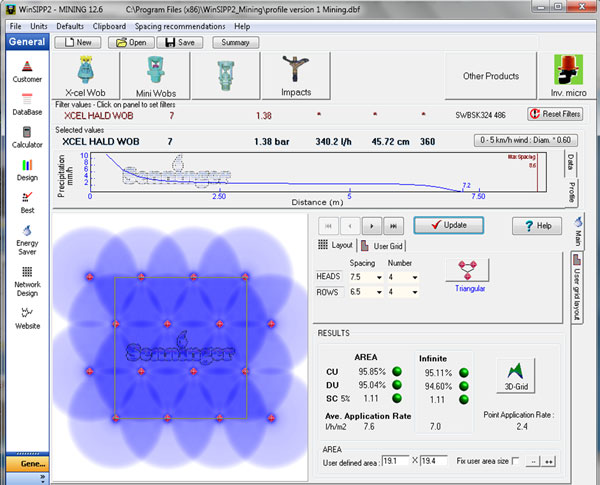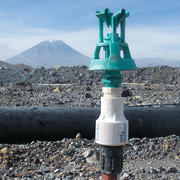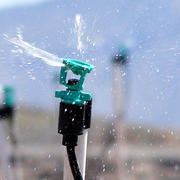Heap leach depths have increased from 50 feet of ore depth to 500 feet since the turn of the century.
Higher closure and reclamation costs as well as a need to minimize the impact on agricultural land prompted mine managers to increase ore depth as a way to make mining operations more efficient and as a way to work around limited surface areas.
While this change has made some mines more efficient, it has also made the recovery of metals more difficult for mines that traditionally relied on drip lines for mineral recovery.
Leaching processes using drip methods depend on source point application of the solution, which promotes channeling. Because there is minimal lateral movement of the solution applied over the ore material, close spacing of the drippers and laterals is necessary to achieve the desired application rate. This increases the potential for clogged orifices and lines due to the small flow passages required.

The Solution
After analyzing the issues, our objective was to create an irrigation system capable of distributing water in a uniform pattern and at an adequate application rate (as determined by a metallurgist) over an entire heap pile. The wetted pattern must also be able to infiltrate the pile at the same point where it falls.
Senninger developed low pressure, 10-20 psi (1.03-1.38 bar) overhead sprinklers that evenly apply solution over large surface areas. They are designed to maximize solution/ore contact, while minimizing the potential for channeling or clogging. These low-pressure sprinklers distribute water in consistently sized droplets resistant to evaporation and wind-drift.
These sprinklers, which Senninger calls their Wobbler products, are designed to:
• Operate at low pressures between 15 to 20 psi (1 to 1.38 bar) to save energy costs
• Wet the entire surface with a 90+% uniformity of distribution in a full 360° pattern
• Irrigate evenly in irregular areas without a need to level the pile
• Adapt to different application and infiltration rates as determined by the mineral type
• Offer the versatility of being moved and used repeatedly
• Provide visual confirmation of uniformity not afforded by surface drip application
• Adapt to pad rinsing for reclamation
• Operate without the need for filtration
• Directly install over existing drip systems if necessary
How much water / solution does the system use?
The application rates for leaching solutions are designed to optimize metal recovery and minimize chemical consumption. Critical aspects of heap leach design are depth of ore, presence of water/solution, and local terrain conditions. It is impossible to determine how much water will be needed or used without taking the above aspects into consideration.
To determine how much you should irrigate, you will need to start with the application rate in liters/hour/m2 the mine’s metallurgist engineer deems appropriate based on the chemical, physical and geotechnical properties of the ore. The acid-water solution should be applied at the beginning, the end or during the entire life of the heap leaching pile.
Using Senninger Mining Software, you can calculate other details such as how many sprinklers the system will need, the ideal spacing between each sprinkler head, the ideal pressure and flow rate, coefficient uniformities and what operating conditions will result in the desired application rate.

System Components
• Pump: Suction, Pump, Motor, Valves
• Conduction Pipe Network
• Lateral Conduction Pipe Network
• Accessories: Fittings, Valves, Flowmeter
• Sprinklers, Risers and Pressure Regulators




